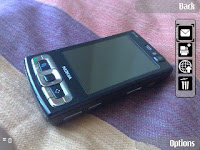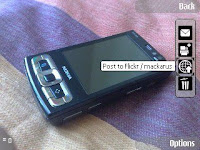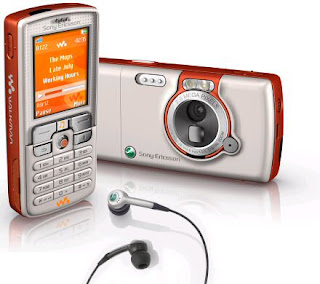Sony Ericsson Sunday night announced its first Windows Mobile phone, the Xperia X1 – and it's coming to the U.S. soon.
"It's a truly converged device for entertainment and productivity. We're trying to avoid the use of the term 'smart phone,'" said Suzanne Cross, head product marketing manager for Sony Ericsson North America.
The Xperia line signals a new focus on innovations in 'user experience' for Sony Ericsson, said Rikko Sakaguchi, the company's head of portfolio and propositions.
"What is tomorrow, what's the vision?" he asked. "A very simplified view is mobile communication with a rich, enriched environment with the Web ... it's not about a great-looking phone or nice design, it's more about appealing to the senses."
Whatever it is, the X1 is smart. The 0.68-inch thick, 5.2-ounce device slides open to reveal a full QWERTY keyboard and a 3-inch, incredibly high-res 800 X 480 touch screen. Yes, that's a higher pixel density than the iPhone.
The X1's specs include, basically, everything. Quad-band EDGE plus quad-band HSDPA 7.2 with HSUPA? Check. Wi-Fi and GPS? Check. A 3.2-megapixel camera with DVD quality video playback and capture? Check. FM radio, Bluetooth stereo, and GPS? You bet. It's all powered by a 520-MHz ARM11 processor running Windows Mobile 6. In short, this thing screams.
To navigate around the X1, you can use the touch screen, cursor keys, or an optical trackpad that works a little like a laptop trackpad.
Sony Ericsson has been making their own effort at fixing the Windows Mobile interface, too, with a new desktop design they call "Experia panels." Panels are essentially large, finger-friendly blocks that sit on your home screen and let you quickly access various applications. Because of the Xperia's ridiculously high-res screen, they look like zoomed-out entire screens of information. Like other maverick Windows Mobile devices such as the HTC Touch and T-Mobile Shadow, though, once you get below the home screen you're back to the old Windows Mobile interface.
The X1 may appear on either AT&T or T-Mobile. Interestingly, Sony Ericsson is producing different variants with AT&T's 850/1900 MHz high-speed frequencies and with T-Mobile's new 1700-MHz high-speed frequency, which they haven't even launched yet.
The X1 will be available during the second half of the year, and don't expect it to be cheap, Cross said.
"It's going to be high-end," she said.
This won't be the only Sony Ericsson Windows Mobile phone, said Pieter Knook, Microsoft's senior vice president of mobile communications."While this is the first, initial product, clearly the anticipation is that there will be a family of products over time," he said.
Sony Ericsson's choice benefits Microsoft, helping Windows Mobile in the consumer space, Knook said.
"Core to our strategy is to expand out from just being business or personal productivity focused," he said.
But the X1 announcement wasn't the only news in a very busy Sony Ericsson press conference. Sony Ericsson also released two new camera phones, a music phone, two ExpressCards and two Symbian UIQ-based smart phones.
The Cybershot C702 and C902 camera phones are both coming to the U.S. in mid 2008, and they each have something not seen in this market before. In the C702, it's a combination of a 3.2-megapixel camera with basic ruggedization, what Sony Ericsson calls splash and dust resistance. In other words, you can drop it in a mud puddle without fear, but not dunk it in a swimming pool. It's also covered with a grippy, rubbery surface.
"This phone is really designed to allow you to take more pictures in more places," said Sven Totte, head of imaging marketing for Sony Ericsson.
The C702 also comes with built-in GPS and Google Maps for Mobile software, and tags your photos with the locations they were taken. A full Web browser, email client, FM radio and Bluetooth round out the feature set.
The C902 is a slim 5-megapixel camera phone with a true Xenon flash, but similar other features to the C702. It's more metallic and skinnier, though, at only 10.5 mm thick. You activate the camera by snapping the top part of the phone up, and then manipulate it with eight dedicated camera settings touch keys studded around the screen.
Both Cybershots are quad-band EDGE phones, which means they could turn up on either T-Mobile or AT&T. Sony Ericsson says they will arrive in mid 2008.
Sony Ericsson hasn't played much in the ExpressCard space here in the U.S. in years – though they do have one ancient card selling on T-Mobile – but the EC400 and EC400g might change that. Both cards are HSDPA 7.2 with HSUPA on the 850/1900/2100 bands and quad-band EDGE – in English, that's AT&T's latest and fastest technology. Both have drivers on board for Windows XP, Vista and Mac OS X so you don't need to download separate drivers. The EC400g adds a GPS unit to your PC, as well. Expect both mid-year.
Sony Ericsson's three other releases will not make it to North America any time soon, company reps said. They include two candy-bar-style Symbian UIQ smart phones, the G700 and G900, which have a neat feature that lets you essentially write sticky notes and tack them to the phone's touch screen to remember things. The Z770i is a midrange clamshell phone with a Web browser and European high-speed networks. Finally, the W980 Walkman music phone is a clamshell phone with 8 GB of built-in storage and an FM transmitter; Sony Ericsson trumpeted this phone as the first of its kind, but the LG Fusic did it in mid-2006.



















